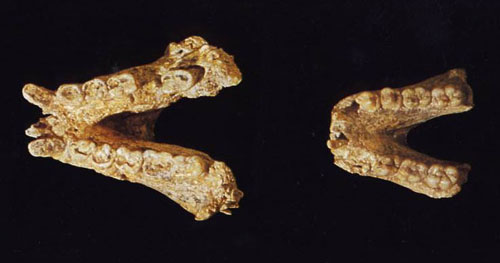|
Fig.1: The mandibles of Gigantopithecus blacki from Juyuandong Cave of Liucheng, Guangxi Province, China.
The extinct giant ape, Gigantopithecus blacki, is a species of large hominoids that dominated the Pleistocene of South China. Its massive mandible, large postcanine teeth and extremely thick enamel always spark people's curiosity about what a diet for this giant ape was. The precise diet and habitat of Gigantopithecus remains unknown so far.
Drs. ZHAO LingXia, ZHANG LiZhao and WU XinZhi, Institute of Vertebrate Paleontology and Paleoanthropology, Chinese Academy of Sciences, and ZHANG FuSong from Institute of Geology and Geophysics, Chinese Academy of Sciences, analyze enamel stable carbon isotope values of G. blacki and the associated mammalian megafauna from two sites in South China, and find that this giant ape and other large mammals solely fed on C3 biomass, and lived in forest habitats, as reported in the journal of Chinese Science Bulletin, 2011(56), No.33:3590-3595.
Zhao and her collaborators prepared and analyzed a total of 32 tooth samples for their study. Four teeth of G. blacki and 24 teeth of associated large mammals were from Longgudong Cave, Jianshi, Hubei Province, and the other 4 teeth of G. blacki were taken from Juyuandong Cave of Liucheng, Guangxi Province. The most enriched δ13C value was -14.1‰, and the most depleted was -18.8‰. Concerning an enrichment of about 14‰ for δ13C between food and enamel, the δ13C values of food sources would be from -32.8‰ to -28.1‰, which is within the δ13C range of C3 biomass and far too negative for that of C4 biomass. It is clear that Gigantopithecus and the affiliated megafauna, such as browsers (Cervus sp. and Tapirus sinensis), grazers (Equus sp. and Leptobos sp.) and carnivores (Pachycrocuta licenti and Ursus sp.), all derived their carbon from solely C3 biomass sources. Zhao and her collaborators suggested that Gigantopithecus should live in closed forest habitat and not an open habitat, which is consistent with the associated faunal and floral analyses.
“Analysis of stable carbon isotopes is a powerful method for exploring the diet and habitat use of extinct herbivorous mammals, and it has been used in paleoanthropology in analysis on early hominins fossils. This method is based on the fact that the carbon isotope composition is significantly different between plants that use different photosynthetic pathways, such as C3 plants (δ13C from -22‰ to -35‰) and C4 plants (δ13C from -8‰ to -16‰), and the stable carbon isotope composition of enamel is dependent on the diet components throughout the food chain”, said Dr. ZHAO LingXia, the lead author and research designer, “The diet and habitat of Gigantopithecus blacki was significantly different from that of early hominins in Africa, such as Australopithecus and Paranthropus, which could consume both C3 and C4 resources and live in open habitats, although they all somehow show similar powerful mastication morphology . Dependence on forest habitat might be an important factor that made Gigantopithecus extinct when the climate and environment changed dramatically during the Pleistocene.”
This work was supported by the National Natural Science Foundation of China (41072016), the State Key Laboratory of Palaeobiology and Stratigraphy of Nanjing Institute of Geology and Paleontology (103105), the International Cooperation Program of MOST of China (2009DFB20580) and the Specific Basic Research Program of MOST of China (2007FY110200).
|
